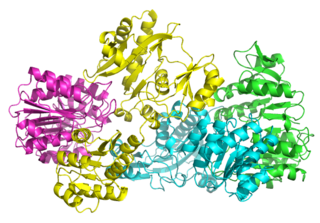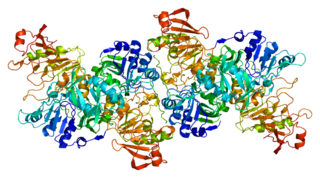Succinyl-coenzyme A, abbreviated as succinyl-CoA or SucCoA, is a thioester of succinic acid and coenzyme A.

Succinyl coenzyme A synthetase is an enzyme that catalyzes the reversible reaction of succinyl-CoA to succinate. The enzyme facilitates the coupling of this reaction to the formation of a nucleoside triphosphate molecule from an inorganic phosphate molecule and a nucleoside diphosphate molecule. It plays a key role as one of the catalysts involved in the citric acid cycle, a central pathway in cellular metabolism, and it is located within the mitochondrial matrix of a cell.
In enzymology, a Hydroxymethylglutaryl-CoA reductase (EC 1.1.1.88) is an enzyme that catalyzes the chemical reaction

In enzymology, a hydroxymethylglutaryl-CoA reductase (NADPH) (EC 1.1.1.34) is an enzyme that catalyzes the chemical reaction

In enzymology, a 3-oxoacid CoA-transferase is an enzyme that catalyzes the chemical reaction
In enzymology, a 3-oxoadipate CoA-transferase is an enzyme that catalyzes the chemical reaction
In enzymology, an acetate CoA-transferase is an enzyme that catalyzes the chemical reaction
In enzymology, an oxalate CoA-transferase is an enzyme that catalyzes the chemical reaction
In enzymology, a succinate-citramalate CoA-transferase is an enzyme that catalyzes the chemical reaction
In enzymology, a succinyl-CoA:(R)-benzylsuccinate CoA-transferase is an enzyme that catalyzes the chemical reaction

In enzymology, a succinate-CoA ligase (ADP-forming) is an enzyme that catalyzes the chemical reaction

In enzymology, a succinate—CoA ligase (GDP-forming) is an enzyme that catalyzes the chemical reaction
The enzyme hydroxymethylglutaryl-CoA hydrolase (EC 3.1.2.5) catalyzes the reaction
The enzyme succinyl-CoA hydrolase (EC 3.1.2.3) catalyzes the reaction
In enzymology, a 3-oxoadipyl-CoA thiolase is an enzyme that catalyzes the chemical reaction

In molecular biology, hydroxymethylglutaryl-CoA synthase or HMG-CoA synthase EC 2.3.3.10 is an enzyme which catalyzes the reaction in which acetyl-CoA condenses with acetoacetyl-CoA to form 3-hydroxy-3-methylglutaryl-CoA (HMG-CoA). This reaction comprises the second step in the mevalonate-dependent isoprenoid biosynthesis pathway. HMG-CoA is an intermediate in both cholesterol synthesis and ketogenesis. This reaction is overactivated in patients with diabetes mellitus type 1 if left untreated, due to prolonged insulin deficiency and the exhaustion of substrates for gluconeogenesis and the TCA cycle, notably oxaloacetate. This results in shunting of excess acetyl-CoA into the ketone synthesis pathway via HMG-CoA, leading to the development of diabetic ketoacidosis.
In enzymology, a dephospho-[reductase kinase] kinase is an enzyme that catalyzes the chemical reaction

In molecular biology, the HMG-CoA reductase family is a family of enzymes which participate in the mevalonate pathway, the metabolic pathway that produces cholesterol and other isoprenoids.
Succinate-semialdehyde dehydrogenase (acylating) (EC 1.2.1.76, succinyl-coA reductase, coenzyme-A-dependent succinate-semialdehyde dehydrogenase) is an enzyme with systematic name succinate semialdehyde:NADP+ oxidoreductase (CoA-acylating). This enzyme catalyses the following chemical reaction

Coenzyme A transferases (CoA-transferases) are transferase enzymes that catalyze the transfer of a coenzyme A group from an acyl-CoA donor to a carboxylic acid acceptor. Among other roles, they are responsible for transfer of CoA groups during fermentation and metabolism of ketone bodies. These enzymes are found in all three domains of life.







